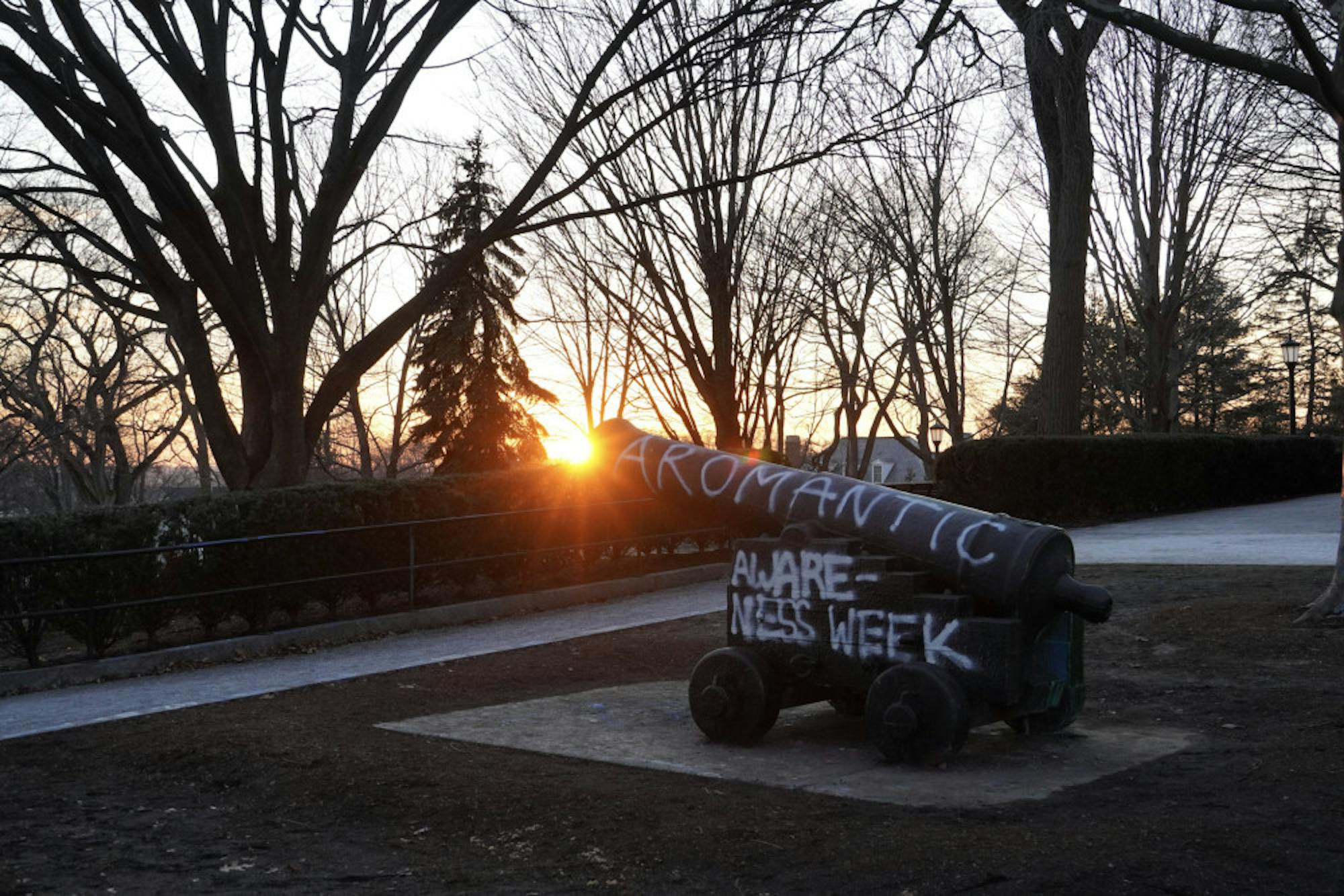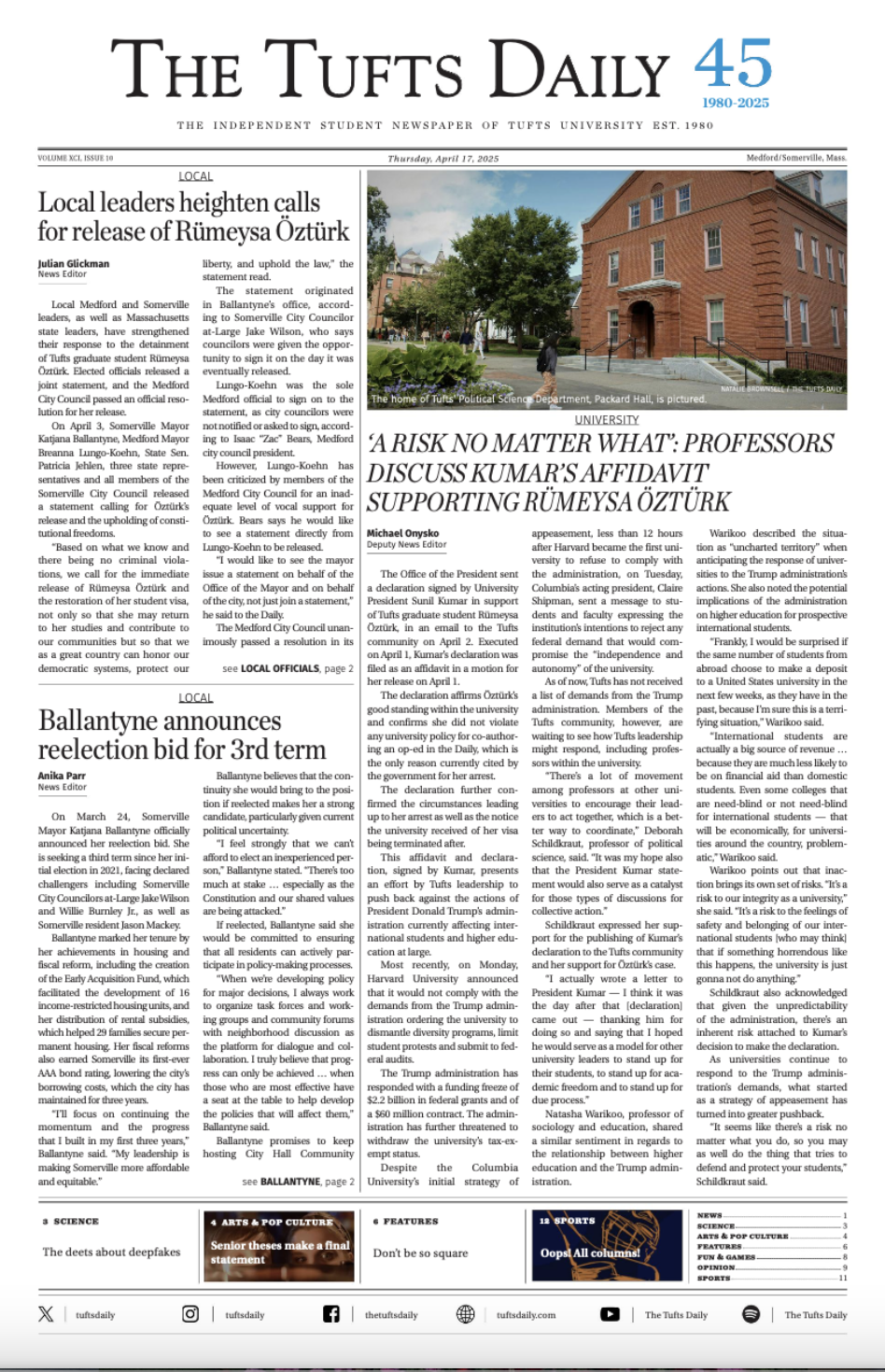Situated between Goddard Chapel and Ballou Hall is the Tufts Cannon, a reigning symbol of the Tufts community and its deeply rooted traditions. The cannon dates back to 1956 when it was gifted to the university by the city of Medford and the Medford Historical Society. The cannon is a replica of “Old Ironsides,” an original cannon from the USS Constitution.
The tradition surrounding the cannon began when a group of students painted it in 1977 in protest of the visit of the First Lady of the Philippines Imelda Marcos, who was there to donate a $1.5 million gift to the Fletcher School’s East Asian and Pacific Affairs program on behalf of the Marcos Foundation and receive an honorary degree. Philippine President Ferdinand E. Marcos had enacted martial law in the Philippines in 1972, and students painted the cannon to protest the Fletcher School’s acceptance of the grant.
Opposed to the protesting students, another group of students painted over their design. Since then, the act of painting the cannon and guarding one’s work overnight has evolved into a longstanding tradition at Tufts.
The cannon continues to serve as a medium for student activism on campus and has been used this semester by many student organizations including the Tufts Philippine Student Union (PSU) and Tufts Climate Action.
PSU hosted a month of events in honor of Filipino American History Month in October. Megan Berja, the senior advisor for PSU, shared that the group decided to kick off the month by painting the cannon on Oct. 6.
PSU met by the cannon at around 10 p.m., and as more people started showing up, the group began brainstorming what they should add to the design. Berja shared that while the club paints the Filipino flag and the letters FAHM, there is usually a debate about what the rest of the cannon should look like.
“People every year have different opinions of what they want to put on [the cannon],” Berja said. “So we tell them [to] go for it. It's a cannon. It's our tradition.”
The history of painting the cannon is very important to PSU, given the tradition’s origin story as a mode of resistance to the Philippines’ authoritarian regime in the 1970s.
Last year, PSU, Tufts Asian Student Coalition, Pilipinx Education, Advocacy, & Resources and Malaya Massachusetts organized an event called “Counterhistory of the Cannon” to educate students about the important history behind Tufts’ longstanding tradition.
Berja elaborated on the context behind the event.
“Tufts doesn’t really publicize the first-ever instance of [painting the] cannon, while … [it] is the university's most important tradition,” Berja said. “We felt that it's important to let the community know that this is how it started.”
Berja reflected on how the Tufts community engages with the cannon in its activism, noting that social media helps amplify and add nuance to simple spray paint designs.
“A lot of the information that we usually put out is too wordy … [and] I don't think that [the cannon can always] give out the full message,” Berja said.
Tufts Climate Action also painted the cannon this semester. The student group was particularly active on campus leading up to and during Tufts Parents and Family Weekend. Posters highlighting Tufts’ investments in the fossil fuel industryand signs calling for university divestment were spread around the campus.
The student group met to paint the Tufts Cannon on Oct. 21, the Friday of Parents and Family Weekend, covering it in large orange words: “NO DONATIONS TILL DIVESTMENT,” “FOSSIL FREE TUFTS!” and “CLIMATE JUSTICE NOW!”
TCA’s primary focus is urging the Tufts administration to divest from fossil fuels, and the group’s presence on campus has taken the form of posters, rallies and demonstrations outside of Ballou Hall.
“Tufts has this whole reputation … [They say they] encourage civic engagement in our student body. Like, ‘we are a progressive and innovative institution that's at the frontier of all these different research,’” Moli Ma, a leader of TCA, said. “With that reputation, and then the other side of it being that we are still invested in this very archaic, bad and immoral industry.”
In years past, the club has used the cannon to challenge the administration. Last year, for example, the club walked over from Ballou Hall after a rally to paint the cannon.
Ma, a sophomore, explained how different student organizations have used the cannon to share their messages with the greater Tufts community.
“The cannon is a go-to for all clubs at Tufts. It's such a deeply ingrained tradition. Everybody walks by, everybody sees it,” Ma said. “We wanted to use it as a way of disseminating information. It's sort of like postering, but it’s a Tufts special edition of getting the word out there about something.”
The tradition also served to connect the student group over a hands-on activity and outside of a traditional meeting setting, according to Ma.
“[It’s] just getting that time to chat with everyone in a very casual setting,” Ma said. “Everybody's figuring out how the spray paint works. [People] were like, ‘Oh, I messed this up.’ And then people are helping each other. So it's very hands-on, instead of us sitting in a classroom and having a formal meeting.”
As TCA looks to the future, Ma shared that the club has many projects in the works, and the cannon will remain a part of their repertoire.
The cannon has become a symbol of student expression on campus, and as such has been widely advertised to prospective students through the undergraduate admissions website and on-campus tours.
Senior Chiamaka Chukwu is a student fellow for Tufts admissions focusing on diversity and access.
Reflecting on her own experience as a prospective student, Chukwu remembers thinking the cannon tradition was unique.
“That's one of the things that made me think that Tufts was super cool,” Chukwu said.
At Tufts, Chukwu painted the cannon her freshman year for the Civic Semester and then with the Student Prison Education Abolition Coalition in a call to defund the Tufts police.
While Chukwu has not specifically advertised the tradition to prospective students in her role in admissions yet, she mentioned the possibility of talking about the unique tradition during her weekly Jumbo Chats on Tuesdays.
“I think it's a really good way for students to express themselves and express certain views that they have, specifically in regards to politics, and I think it's also a good way to inform the campus [about various issues],” Chukwu said.
Chukwu also pointed out the ephemeral nature of a cannon painting.
“I think what makes it really tricky is the fact that … if you want your stuff to stay on the cannon for a long time, you have to guard or protect it because people could paint over it,” Chukwu said. “So that's the one thing that I'm like, I wish this wasn't the case. But I do think it's a really good way for students to express themselves and I'm pretty glad that Tufts has that as a part of their tradition.”
Chukwu shared her view on how the Tufts community can engage with the cannon in a more thoughtful and intentional manner, going forward.
“I don't know if I would say that painting the cannon has necessarily contributed to supporting marginalized communities on campus,” Chukwu said. “I previously talked about how [the cannon] gets painted over really easily. So I feel like if there’s something a Black or Indigenous person wants to make super aware to campus, they kind of have to guard it so that it's not painted over.”
As you pass between Goddard Chapel and Ballou Hall at night, you may just catch students huddled around the cannon, planning out what they should paint next. For student groups looking to reach the greater campus, the tradition of the cannon has and will continue to exist as a prominent force of student activism and expression within the Tufts community.






